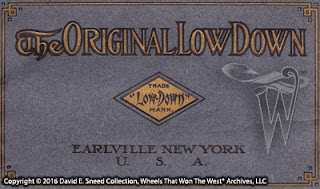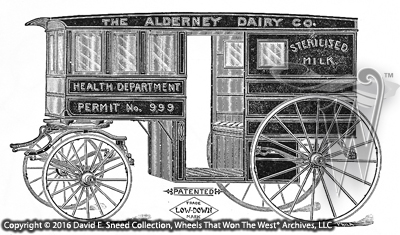With thousands of different types, sizes, and brands of early horse-drawn wagons used in America, studying this part of our past can sometimes be overwhelming. There are so many facets to the subject that we will likely never know every part of our transportation history. That said, there is a great deal that we do know and much of that still has a way of going largely unnoticed.
Patented designs, for instance, are not often highlighted - even though the information is important to the understanding of a vehicle's design, value, rarity, and overall provenance. One example of what, today, might be looked upon as a common design is a series of business wagons built by J.R. Parsons of Earlville, New York. The custom form was patented in 1890 and almost immediately referred to as a 'Low-Down' wagon. To our 21st century way of thinking, the term may sound derogatory, as though it was referring to a worthless or less-than-savory wagon experience. In this case, though, the name points to the low-slung, physical nature of the design. In fact, the phrase was so defining it was trademarked by Parsons.
 |
| This logo was trademarked by the early 1890's and used to heavily promote the namesake designs as being exceptionally comfortable, efficient, and profitable. |
There were a host of benefits to the Low-Down design and many of the advantages were (and still are) easy to see. From an overall perspective, the main body was engineered to hang below the axles. It's a configuration that makes the vehicle easier to load and unload; no doubt, a big plus when you're carrying heavy articles to and from the wagon. In addition, the dropped body helps place more weight in a lower position, where it's easier to draw by a single horse or team.
Those with milk deliveries were among the biggest users of the unique designs. Some of these operators even claimed that the layout allowed them to deliver a third more milk in a given timeframe. Period sales literature touted the rewards of the design and claimed users could benefit from time savings, convenience, comfort, and profitability. Many of the wagons were also equipped with a patented, ball-bearing fifth wheel that required no oil or grease - so it was always clean.The cut-under pattern was said to turn as easily when loaded as empty, so the user had no more worries with broken shafts and unnecessary strain on the horse.
Beneath the body, the forward portion of the gear was initially constructed with a reinforced A-frame support and diagonal, elliptic springs on the front axle (later designs did not necessarily have the A-frame configuration). The upshot to the plan was that it allowed the wagon to turn tighter without sacrificing interior space, comfort, stability, and ease of access. The rear half of the gear utilized a regular platform hung from irons that extended under the body. In essence, the wagon enjoyed great stability with a series of smooth-riding, elliptic springs.
The bodies were fabricated from ash and oak while the wheels were said to be hickory with Sarven hubs and riveted felloes. Collinge collar steel axles protected the spindles and hubs from dust and grime while capacities on these light-running wagons could range from 600 to 2500 pounds. Prices in the mid-to-late 1890's were compatible with medium and heavy capacity farm wagons, ranging from $130 to just over $200.

The Parson's "Low-Down" wagon was used for a multitude of business purposes.
While popular with the milkman, the Parsons' wagon was also readily adapted by those in the bakery, butcher, laundry, florist, department store, ice cream, and retail grocery businesses. Even so, if a person still wanted a more traditional body mounted atop the axles, Mr. Parsons did offer a taller, straight sill wagon. Since those models had a higher center of gravity and a much smaller turning radius, though, most folks gravitated away from the old style and readily adapted the new, 'Low-Down'designs. Some will note that the company actually had another, even earlier, wagon patent dating to 1888. This design innovation, though, utilized a tapered body which affected interior space. This issue was overcome with the updated 1890 patent. So, top to bottom, that's the low-down on the 'Low-Downs.'
Please Note: As with each of our blog writings, all imagery and text is copyrighted with All Rights Reserved. The material may not be broadcast, published, rewritten, or redistributed without prior written permission from David E. Sneed, Wheels That Won The West® Archives, LLC